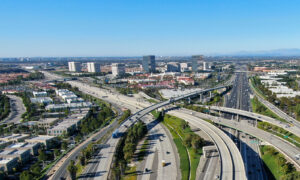Few cities have 80% of their traffic signals synchronized. Or a fully staffed traffic management center. Or traffic signals that employ artificial intelligence.
In Irvine, these are all innovations used to keep things moving.
“Our goal is to use technology to increase safety, reduce traffic congestion and reduce carbon emissions,” says Jaimee Bourgeois, Irvine’s deputy director of transportation.
Here’s a summary of what the city is doing.
Synchronized signals
The city recently re-synchronized 98 traffic lights along Irvine Boulevard, Irvine Center Drive and Von Karman, upgrading Irvine’s 19 fully synchronized corridors.
“We’ve done studies on these corridors, and we’re seeing an 11% to 25% reduction in travel time,” Bourgeois says.
More than 300 Irvine traffic lights have been synchronized for morning, midday and evening commutes – eliminating nearly one-third of the stops a motorist would have encountered without synchronization.
Traffic Management Center
When there’s a flat tire on I-405, engineers in Irvine’s Traffic Management Center jump into action. By pulling up live video feeds, they can quickly adjust signals along Irvine arterials to keep detoured cars moving.
“That’s one area where we really differ from other cities,” Bourgeois says.
Using a wall of TV monitors that resembles NASA’s Mission Control room, engineers can adjust any of 378 signaled intersections, seven days a week, to account for commute times, construction, accidents and special events.
‘Smart’ streets
This month, UC Irvine and the city will equip 25 intersections with emerging-technology traffic sensors that use artificial intelligence to improve traffic efficiency.
Campus Drive, Culver Drive and University Drive are leading candidates for the project, which is funded by a $6 million Department of Energy grant to UCI’s Samueli School of Engineering.
In the future, all streets are expected to use this kind of technology, but Irvine is among the first to test-drive it – for now, creating 25 of the smartest streets in America.










